Aleutian and Pribilof Islands: Beauty, Tradition, Tragedy
This Unangan ceremony was held to honor those who perished in the Killisnoo Internment camp during WWII. The memorial service marks the end of a journey that began for the Unangan people thousands of years before, when their ancestors crossed from Asia to Alaska.
It might be said that the history of the Aleutian archipelago, and the indigenous people who settled there, has been shaped by geography. While this is true for all peoples, everywhere, in the case of the Unangan and the land they settled, this has been a stark reality. From the violent formation of the Aleutian Arc, to the prehistoric migration from Asia, and the conquest in modern times by powerful neighbors, the Unangan people have been obliged to conform to external forces.
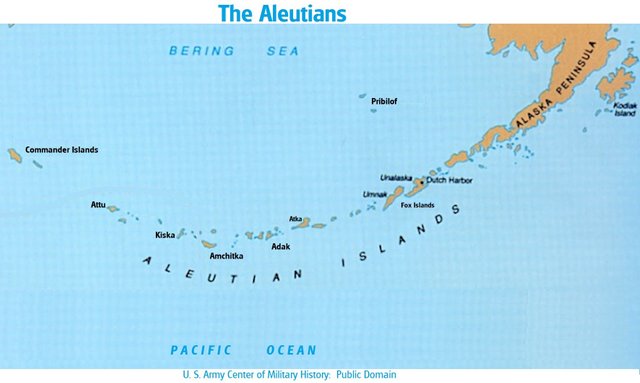
The Commander Islands, on the far western end of the Aleutian
Archipelago, are part of Russia. The five islands north of the
archipelago, in the Bering Sea, are the Pribilof Islands. The two
largest of these, St. George and St. Paul, are breeding grounds for the protected northern fur seal. As will be explained later in this blog, the seasonal migration of the seals had a profound effect on the destiny of the indigenous people of the Aleutian and Pribilof islands.
Northern Fur Seals Return to the Pribilof Islands to Breed
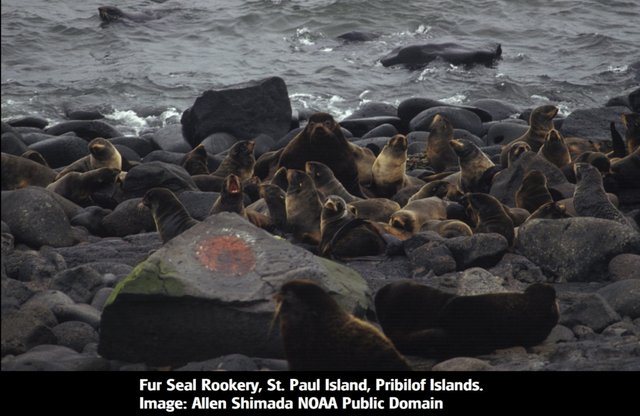
Climate/Weather
The World Wildlife Fund characterizes the Aleutians as a group of sedimentary islands capped by volcanoes. The climate is described as 'maritime': the heat of summer and cold of winter are moderated by proximity to water. According to the website weatherspark, which advises travelers about local conditions, temperatures on Unalaska, one of the largest of the Aleutian islands, range from from 30º to 56º F throughout the year. More significant than temperature, for travelers and those who depend on the sea for livelihood, are the winds that whip across the islands. The Aleutians are among the windiest places in the U.S.
The islands are virtually treeless, although there may be found on some islands shrubs, dwarf willow and crowberry.
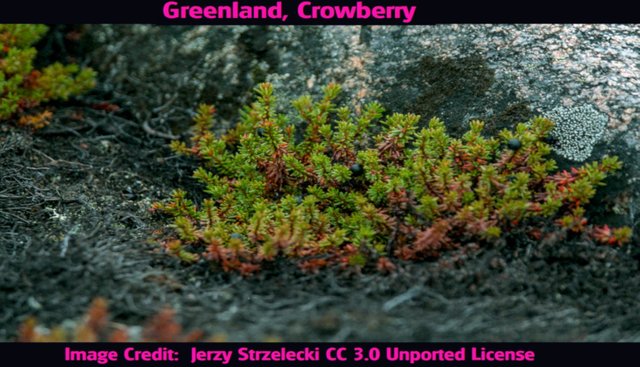
Meadows, grassy areas and peat bogs are typical of lower elevations. The soil is not suitable for farming, other than small vegetable gardens. The indigenous people of the Aleutians have traditionally been dependent on the sea for food, clothing, and other aspects of daily life.
According to the U. S. Fish and Wildlife Service, the only native mammals on the Aleutian Islands are marine mammals. An exception to this is the red fox, which is endemic to some eastern islands in the archipelago.
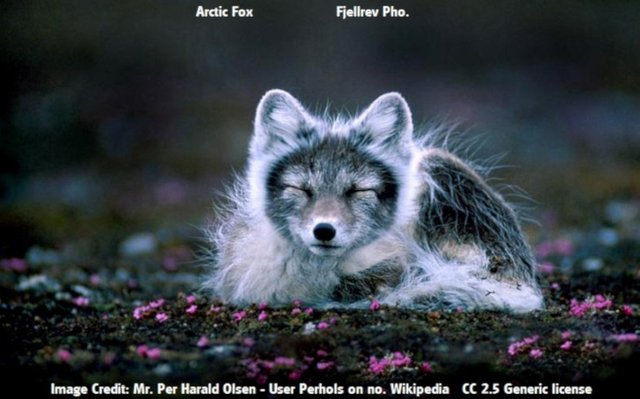
The Arctic fox is an introduced species in the Aleutians. An analysis by the U. S. Geological Survey explains how this species not only endangered ground-dwelling birds native to the islands, but also had a profound effect on the landscape. Lush vegetation, which was characteristic of some areas, was dependent on bird droppings for fertilization. Once the birds were decimated by the predatory Arctic fox, grasslands withered and were replaced by 'scrubby' tundra.
The fox was originally introduced by fur traders, who bred the animal for its valuable pelts.
According to Nature Conservancy, the Aleutian Islands are the best seabird habitat in North America. Red-legged kittiwakes, Aleutian terns, red-faced cormorants and several auklet species nest only in the Aleutians. There are also birds that breed elsewhere but come to the Aleutians during warm months to feed. Among birds endemic to the islands are the Aleutian cackling goose and several species of rock ptarmigan.
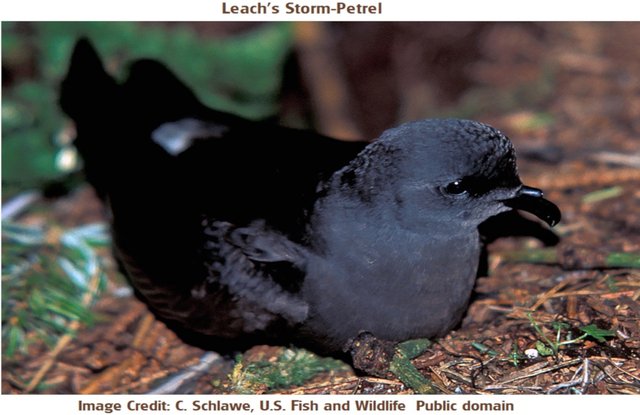
The bird pictured above was threatened with extinction on what was formerly known as Rat Island. This island had been overrun by another introduced animal, the Norwegian rat. Conservationists went to work, and eliminated the rats. With the rats gone, birds returned, not only Leach's storm-petrel, but other birds as well. The name of the island is now Hawadax Island, which is a name chosen by the Unangan people.
Melting Sea Ice and Aleutian Ecology
The Aleutian Arc supports a rich abundance of wildlife. One factor that enables this wide variety to flourish is plankton, upon which many species depend, directly or indirectly. According to a report issued by The National Academies of Science, Engineering and Medicine, the amount of plankton present each year is related to the date at which winter sea ice retreats from the ocean cover. "Thus, any change in the timing of ice retreat during the late winter/early spring will likely have a major impact on ecosystem structure."1
Geology
A Clash of Titans: Tectonic Plates
The Aleutian Arc was formed by, and continues to be shaped by, the violent convergence of two massive tectonic plates. One plate must bow as it is submerged under the other (subduction). In this case, the dense Pacific Plate is forced under the lighter North American Plate. The submerging plate falls into the mantle of the earth and melts into magma. The magma rises, solidifies and forms islands. In the case of the Aleutians, a string of volcanic islands were produced, 57 in all.
The clashing together of the plates is experienced as a violent shaking--earthquakes--along fault lines.
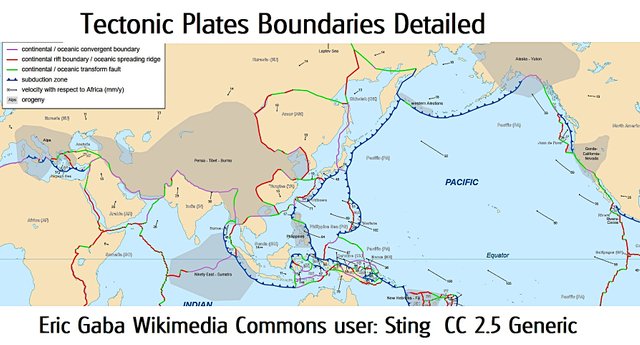
The illustration shows the movement of the plates that formed the Aleutian Arc. A dynamic representation of the plates, fault lines and volcanic activity, may be seen here
Ring of Fire
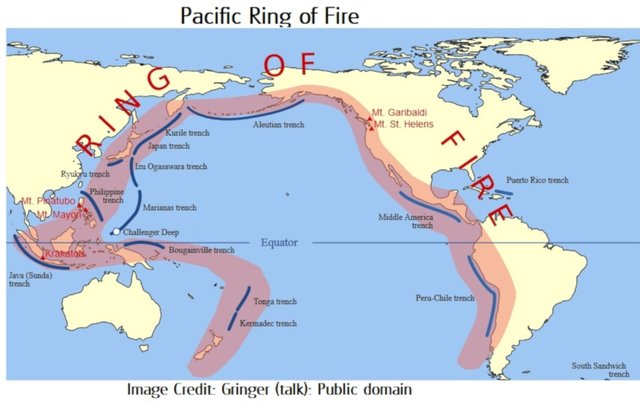%20CC%20free.jpg)
The Aleutian Islands form the northern perimeter of the Pacific Ring of Fire. It is estimated that 75% of the world's volcanoes occur along the Ring. The perimeter of the Ring is made up of the "Pacific, Juan de Fuca, Cocos, Indian-Australian, Nazca, North American, and Philippine plates". 2
People of the Aleutian Archipelago
Who were the first people to settle the Americas? How did they arrive? Where did they settle? These questions are still open. One thing is fairly certain: some these people crossed a land bridge on the Bering Sea that connected Asia to North America. Known as Beringia, this bridge has a fascinating history all its own.
Migration of Early Peoples
Beringia
An article published by the US National Park Service explains that, as the last Ice Age was coming to an end, some 10,000 years ago, frigid conditions caused glaciers to form in northern regions of the globe. Water was drawn into the glaciers and sea levels fell. In some places the decline in sea level was as much as 300 feet. One area affected was the Bering Sea, where a grassy plain rose out of the water. This land mass stretched 1,000 miles, north to south, and connected Asia to North America. It was across this bridge, evidence suggest, that the first people of Alaska crossed from Asia.
The Bering land bridge was more than a path. It was a place, many scientists suggest, where life flourished. Animals grazed and flora grew. People settled. The idea that a settled community existed on Beringia is called the Standstill Theory. Recent DNA analysis of fossils gives strength to this theory.
The flow of life across the Bering land bridge went in both directions, creating forward and back migrations. The land bridge supported life, according to Julie Brigham-Grette, a geoscientist at the University of Massachusetts-Amherst, for 15,000 years.
In time, as the earth warmed, waters rose again. The Bering Sea covered the land once again and only scattered island chains remained above sea level. Among these islands were the Pribilof and Aleutian achipelagos. It would be thousands of years, though, before the earliest humans arrived.
Current evidence suggests that the indigenous population of the Pribilofs and the Aleutians, the Unangan people, benefited from a series of migrations over thousands of years.
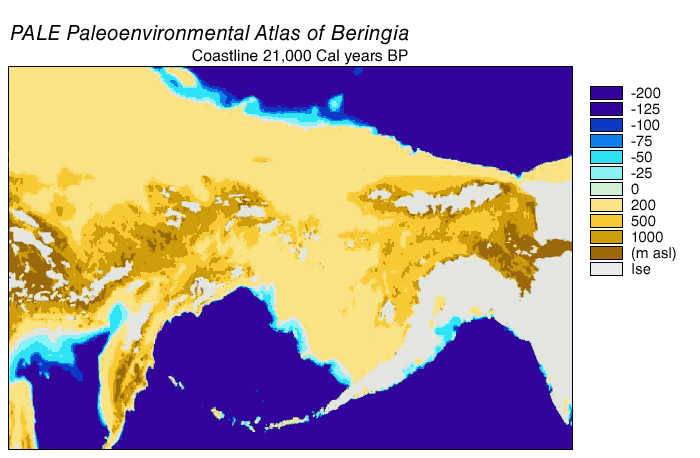
Image credit: U. S government, NOAA. Public domain
The GIF shows that changes in the Bering Sea land bridge over time, as waters rose and fell.
Tracing Clues of Early Migrations
DNA, archeological artifacts, and language offer clues about the ancestors of the Unangan. The dates of various migrations into Alaska, and specifically into the Aleutians, are debated.
It was long accepted by the mainstream archeological community that the earliest migrations of people into Alaska occurred 14,000 years ago. However, recent discoveries have pushed that estimate back by at least 10,000 years.
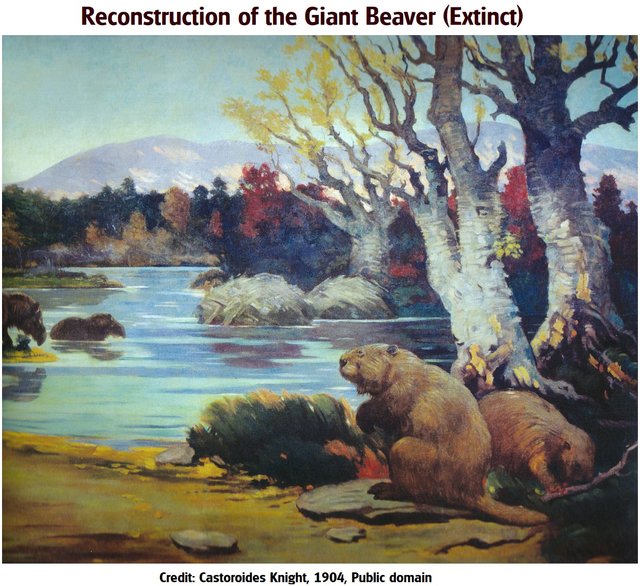
The giant beaver is one of many animal fossils found at Beringian archeological sites. These sites include Crow Flats and Bluefish Caves. Other animal species found include mammoths, camels, bears and sloths. Some of the animal bones showed evidence of having been cut by human tools. Therefore, dating the bones helps to determine the period in which humans occupied Beringia.
It is believed that settlement of the Aleutian Islands occurred later than settlement of mainland Alaska. Settlement in the Aleutians began on the eastern islands, or so the evidence seems to show, and then extended west. The Pribilof Islands, which are north of the Aleutians, were not settled until the eighteenth century.
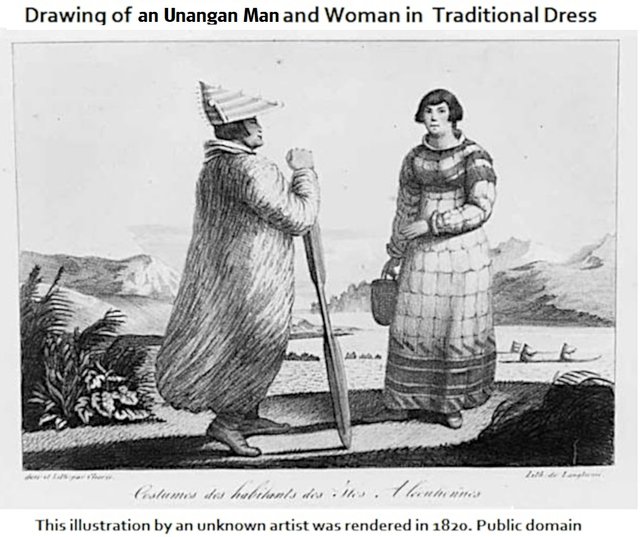
Possible Migration Routes and Cultural Diffusion
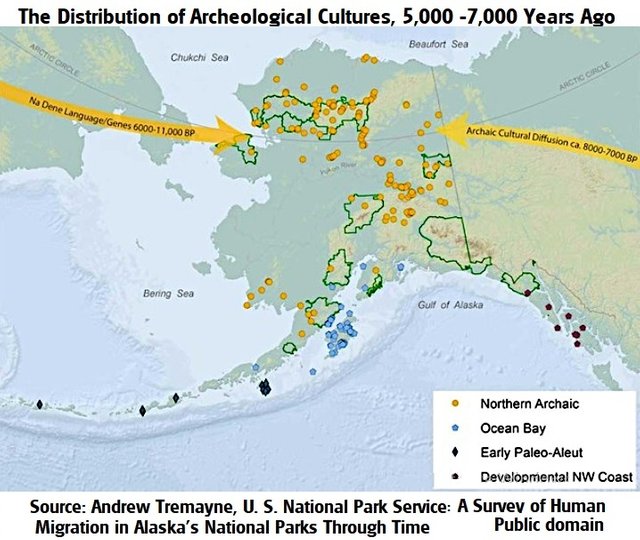
DNA Evidence
A genetic profile of the Unangan was worked up by Max Planck Institute and a report published in the June, 2019 issue of Science Daily. This report revises earlier theories about Unangan origins. According to the analysis of the Institute, there was a series of migrations, but one of the most significant occurred 5,000 years ago, when a people known as the Paleo Eskimos arrived in Alaska. The influence of this migration extended not only to Alaska and the Aleutians, but also further south, to the indigenous populations of North America. "The ancestors of Aleutian Islanders and Athabaskans derive their genetic heritage directly from the ancient mixture between these two groups."3
Thus, the Unangan people of the Aleutian Islands have a blended heritage, which benefited from early and later migrations.
Archeological Evidence: Anangula and Aleutian Traditions
The archeological evidence that tells us about prehistory on the Aleutian Islands is comprised mostly of stone tools. From examining these artifacts, archeologists deduce that the first residents of the Aleutians emigrated from the Alaskan mainland about 9000 years ago.
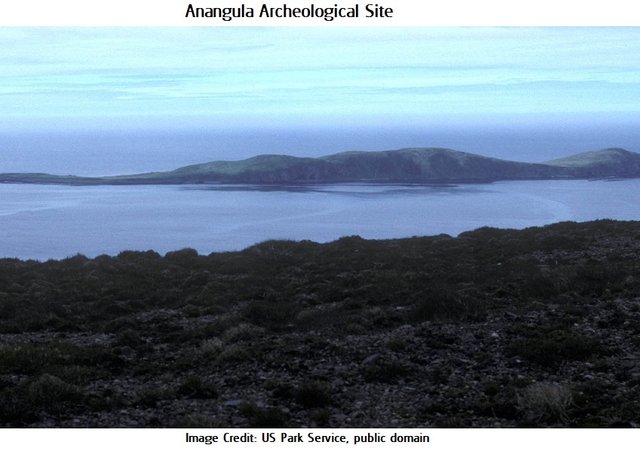
The earliest signs of human habitation in the Aleutian Islands have been found at Anangula, on Umnak Island. These artifacts, stone tools, are so distinctive and of such significance, that the period they represent has been called the Anangula tradition.The tools include "... a variety of skin scrapers, knives, and burins (gouging tools)".4
The Anangula Tradition seems to have lasted for a few thousand years. Then, the distinctive tool style changed, although the style of other artifacts did not. Those that remained consistent included "...roof-entry semi subterranean houses (see the discussion of houses below), large stones for grinding paint pigments, stone bowls and oil lamps, and pumice abraders."5
The change in tool style took place about 5,500 years ago. The Anangula Tradition was replaced by a new archeological period, which is known as the Aleutian Tradition. Artifacts from this later period yield rich clues about the people who lived in that time. The artifacts include spearheads, harpoons and personal items.
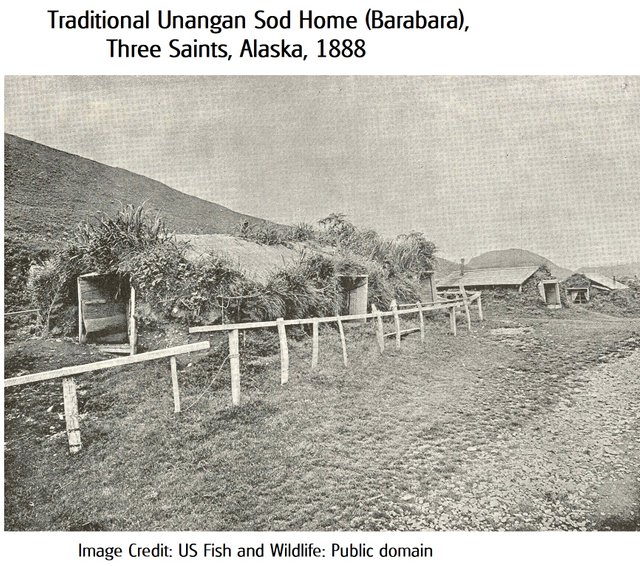_of_the_Indian_Village_of_Three_Saints,_Old_Harbor,_Kadiak.jpg)
Language
Language may be used as map to trace a people's history. The traditional term for the indigenous language of the Aleutians is Unangax. The word 'Aleut', it is believed, is Russian in origin. The Unganan language is part of the Eskimo-Aleut family. According to Alaska State University linguist Anna Berge, there is a shared origin between Unangan and Eskimo languages. However, today these languages are distinct, and not mutually intelligible.
Dr. Berge suggests that the morphology of Unangax indicates geographic isolation of the Aleutian Islands from Eskimo groups. The isolation, though, was not complete. There are enough similarities to suggest repeated contact between the Unangan and their Eskimo neighbors.
Within the Unangan people themselves, dialects arose but usage was sufficiently similar to allow communication between different island groups. Today Unangax is a language in danger of extinction. According to the Aleutian Pribilof Islands Association, there are only 109 people who speak the language fluently.
First Foreign Contact: The Russians
The story of contact for indigenous people has been told with wearying familiarity across the globe. The grim saga begins with conquest. It is followed by subjugation, and often the introduction of annihilating disease. Russia's early interaction with the Unangan followed this grim pattern.
First contact with the Aleutians occurred in 1741, when two explorers from Russia, Vitus Bering and Aleksei Chirikov, came upon the chain. Bering landed on a western portion of the archipelago. He perished, though others in his crew survived. Chirikov landed on what would one day be Sitka Island. From these two voyages came the information that the islands could be a source of valuable furs. Hunters and traders soon descended on the islands. Russian Orthodox missionaries followed in very little time.
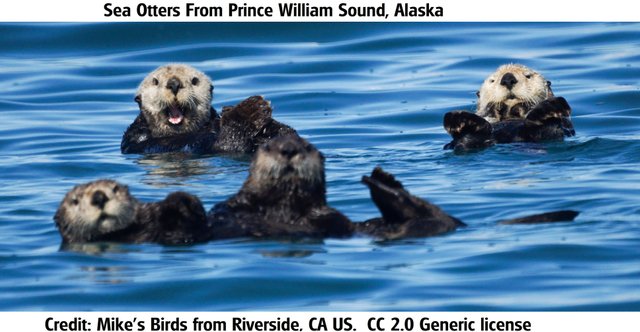
Traditional Unangan culture was tied to the sea. It centered around hunting and harvesting sea animals. All parts of the animal were utilized: fur became clothing, skin covered lightweight kayak frames, bone became tools, flesh became food.
With Russian contact, the modern era of the Unangan people began. Battles were fought between invaders and the invaded. The Unangan were kidnapped and forced to work at slaughtering sea mammals and harvesting their skins for trade. Disease raged through the indigenous population. It is estimated that before the time of contact the combined population of Aleutians may have been in excess of 25,000. By 1800, the population had declined by 80%.
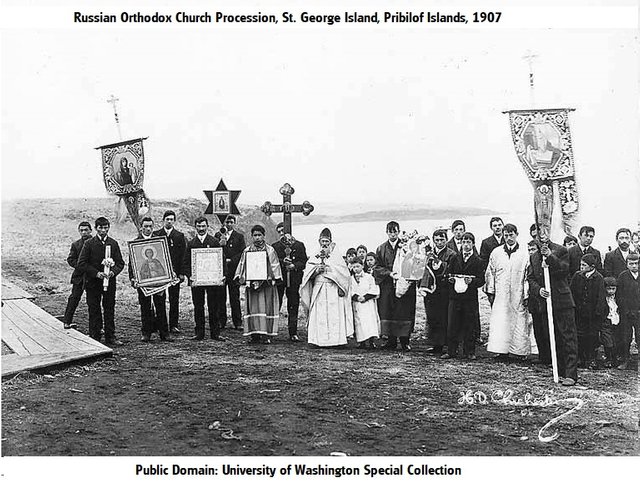
In 1786 the Pribilof Islands were 'discovered', as were the seals that used the islands for breeding grounds. Fur traders quickly set about exploiting this rich source of pelts. A new era of enslavement began for the Aleutian people. They were forcibly transported to the Pribilofs and compelled to work.
A culturally transformative effect of contact with Russia was the establishment of the Russian Orthodox Church. To this day, the Church exerts a powerful influence on the Unangan.
The Americans
Transfer of the Aleutian Islands to American control occurred in 1867.
All but the Commander Islands became U. S. territory. According to the Aleutian Pribilof Islands Association, there were no significant changes between the Russian and American periods. The Russian Orthodox Church continued to exert its hold.

The lure of the fur trade continued, as did the desire to profit from this trade. According to Helen Corbett and Susanne Swibold, authors of "Endangered people of the Arctic: Struggle to Survive", after control of the Aleutian and Pribilof Islands passed to the United States, the Unangan people became wards of the United States government. They did not enjoy Constitutional protections granted to U. S. citizens.
Citizenship was finally granted in 1924, to the Unangan and all native Americans born in the U. S. However, the Unangan living on the Pribilof Islands were not free from government control. Forced labor continued. Not until Congress passed the Fur Seal Act in 1966 were Pribilof residents freed. Though the act was passed to protect the seals (!!), its passage had the effect of ending forced labor on the Pribilof Islands.
WWII: Japanese Invasion and U. S. Internment Camps
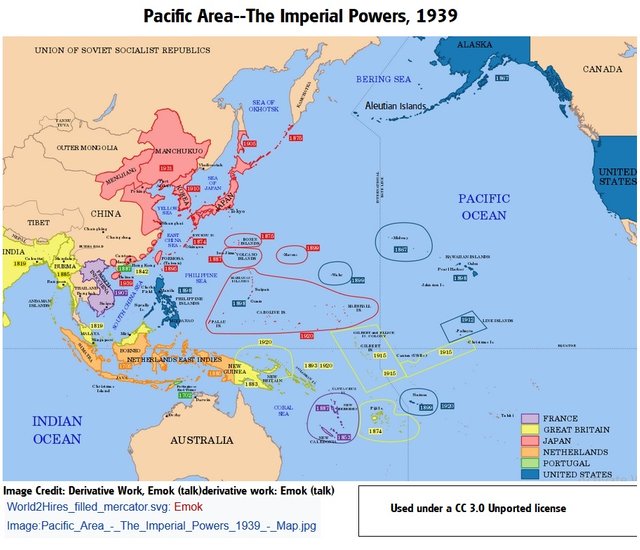
The proximity of Japanese Territory to the Aleutian Islands can be seen easily on the map. On June 3 and 4, 1942, Japan bombed a U.S. naval base on Unalaska. On June 7 and 8, they invaded two islands: Attu and Kiska. The naval weather station on Kiska was overtaken. The indigenous civilians on Attu were captured and transported to Japan as prisoners of war.
The invasion by Japan began another tragic episode in the history of the Unangan people. The Aleutian Islands represented a critical strategic weakness for the United States. In order to shore up defenses against further attacks, and prevent the Japanese from gaining more footholds in U. S. territory, dramatic action was taken. Unangan civilians were hastily evacuated from their homes on the Aleutian and Pribilof Islands. These civilians were sent to internment camps.
Years later, the internees testified about their experience.
Philemon M. Tutiakoff:
"The overcrowded conditions were an abomination. There were 28 of us forced to live in one, designated 15'x20' house. There existed no church, no school, no medical facility, no store, no community facility, no skiffs or dories, no fishing gear and no hunting rifles." 6
Alice Petrivelli (who was interned at Killisnoo):
"We got to Killisnoo and most of the houses were in disrepair. The only decent house there they gave to Mr. and Mrs. Magie [Magee], the teachers, the only one that had the stove...later on, the men were able to repair the homes and eventually everybody had their own little apartment. Like we lived in a two room place, which was - well, summertime it was all right but wintertime it was icy cold and I remember being hungry. Some days were okay because we were able to get clams and crabs and fish, but a lot of the time we had nothing. Well we did not have guns. We were not able to go out and get our own food". 7
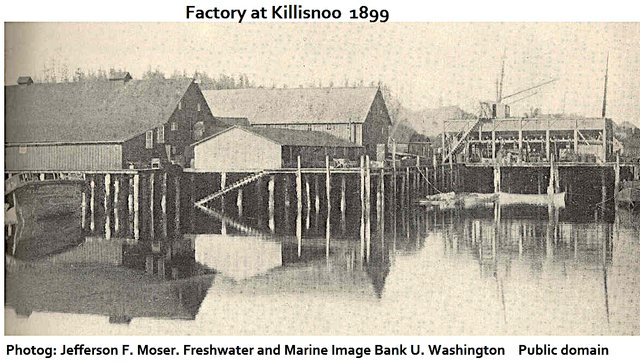
There were deaths, especially among the young. According to the U. S. Park Service, of the 83 evacuees from Atka who were interned at Killisnoo, seventeen died.
The U. S. National Archives offers a fairly detailed record of how the evacuation of the Aleutian Islands proceeded. Many months before, in January of 1942, the peril of a Japanese invasion was clearly understood. A representatives of the Navy wrote to Paul Gordon, of the Division of Territories at that time:
"It is felt that the evacuation of all white women and children from Unalaska would be to the best interest of the present military situation." 8
It would be difficult to avoid the suggestion that racism likely played a role in the failure to evacuate the Unangan in a timely fashion.
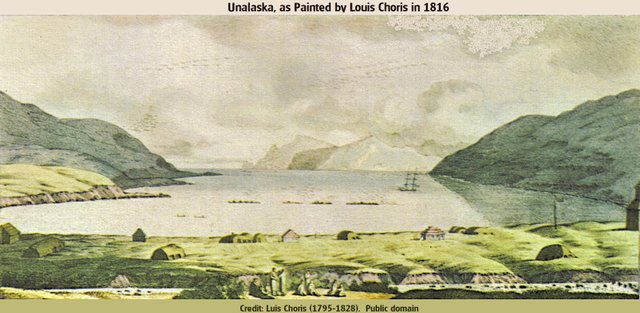
A hasty evacuation of the indigenous people was arranged only after the Japanese had actually seized territory in the Aleutians. Disinterest in the well-being of the evacuees was evident from the first instance. For example, as a crowded steamer left Unalaska with evacuees and sailed toward the internment camps, a doctor on board from St. George Island felt no responsibility toward the passengers. A nurse who was present testified:
"...He did not come to assist even at the birth of a St. George baby or its subsequent death of bronchial pneumonia"9
The Unangan Return
As the evacuees had been obliged to leave almost all their personal possessions behind, they returned with very little. Most found on their return that their homes and possessions were gone. The military had followed a 'scorched earth' policy on the islands so the Japanese would have little resources if they did occupy the islands. Additionally, it was evident that U.S. personnel stationed on the islands, for the most part, had little regard for what they found.
Again, a witness statement:
"...Clothing had been scattered over floors, trampled and fouled. Dishes, furniture, stoves, radios,phonographs, books, and other items had been broken or dam-aged. Many items listed on inventories furnished by the occupants of the houses were entirely missing. . . . It appears that armed forces personnel and civilians alike have been responsible for this vandalism and that it occurred over a period of many months.." 10
Many communities that had existed before the war disappeared. Some were consolidated into larger communities. In some instances, people were not allowed to return. In others, they chose not to return.
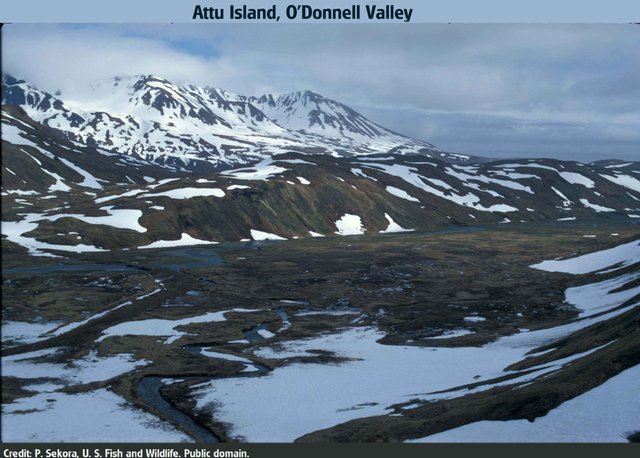
Attu islanders who were taken prisoner by the Japanese did not fare well. Many died in captivity.
In May of 1943, the U.S. waged a battle to reclaim Attu Island. It is estimated that 1,000 U.S. soldiers and 2,000 Japanese soldiers fell in this fierce struggle, in which U. S. forces were victorious. The Battle of Attu was the only one waged on U. S. soil during WWII.
Today Attu Island is uninhabited, except for wildlife. A memorial stands to honor those who fell in battle.

Epilogue
I began this piece after coming across an article about the Battle of Attu. Before that, I knew little about the Aleutian Islands. However, the saga of the Unangan, and their determination to preserve their culture moved me. And so this post was born. Some of the references cited here are rich with information that could not be included. Especially gripping were reports from the Aleutian Pribilof Islands Association, the National Archives and the National Park Service.

Footnotes
1 The National Academies Press: The Environmental Setting The Physical Environment
2 National Geographic: Ring of Fire
3 Science Daily: Ancient DNA sheds light on Arctic hunter-gatherer migration to North America around 5,000 years ago
4 Aleutian Pribilof Islands Association: History
5 Ibid
6 U. S. Park Service Evacuation and Internment
7 Ibid
9 Ibid
10 Ibid
Some Sources Used in Writing the Blog
Geology Page: Aleutian Islands
National Park Service: Charles House
Army Times: 75 years later, ‘forgotten’ WWII battle on Alaskan island haunts soldiers
US Army Center of Military History: Aleutian Islands 1942-1943
National Park Service: Evacuation and Internment
Aleutian Pribilof Islands Association: History
American Journal of Human Genetics: Analysis of Mitochondrial DNA Diversity in the Aleuts of the Commander Islands and Its Implications for the Genetic History of Beringia
US National Part Service: World War II Aleut Relocation Camps in Southeast Alaska - Chapter 4: Killisnoo Herring Plant, pt. 1
LiveScience: What Is a Subduction Zone?
Timeline: [To protect indigenous Alaskans from Japanese bombs, the U.S. gave them… internment and death] (https://timeline.com/indigenous-alaskans-japanese-bombs-internment-wwii-cebe47860665)
Alaska Magazine: The Pribilof Islands
U.S. Fish and Wildlife Service: Refuge History - 1900-1945
KTOO News/Public Media: For decades, the government stood between the Unangan people and the seals they subsist on. Now that’s changing.
U.S. Geological Survey: Jurassic phase, Alaska-Aleutian Range batholith, undifferentiated
National Park Service: A Survey of Human Migration in Alaska's National Parks through Time
Sciencing: What Type of Plate Boundary Is the Aleutian Trench?
Science Daily: Ancient DNA sheds light on Arctic hunter-gatherer migration to North America around 5,000 years ago
NPS Bering Land Bridge: Other Migration Theories - Bering Land Bridge National Preserve
Études/Inuit/Studies: The Northern Fur Seal: A Subsistence and Commercial Resource for Aleuts of the Aleutian and Pribilof Islands, Alaska
The National Academies Press: Decline of the Steller Sea Lion in Alaskan Waters: Untangling Food Webs and Fishing Nets
World Wildlife Fund: Aleutian Islands
U. S. Fish and Wildlife Service: Marine Mammals of the Aleutians Islands
U. S. Geological Survey: Study Shows that Introduced Foxes Transformed Vegetation on the Aleutian Islands from Lush Grassland to Tundra
U. S. Forest Service: M127 Aleutian Oceanic Meadow--Heath Province
Nature Conservancy: Alaska Stories
Human Biology: Origins of Linguistic Diversity in the Aleutian Islands ](https://www.jstor.org/stable/41466704?seq=1#page_scan_tab_contents)
Journal of Historical Linguistics: Re-evaluating the reconstruction of Proto-Eskimo-Aleut
National Geographic Resource Entry: Ring of Fire
Smithsonian National Postal Museum: As Precious as Gold
Current Biology: Y Chromosome Sequences Reveal a Short Beringian Standstill, Rapid Expansion, and early Population structure of Native American Founders
Encounters: Alasak: The Alaska Fur Trade
Arctic Anthropology: Animal World of the Aleuts
The World of Elephants International Congress, Rome 2001: On the significance of modified mammoth bones from eastern Beringia
Robert Welch University: Quest of a Hemisphere, Chapter 21
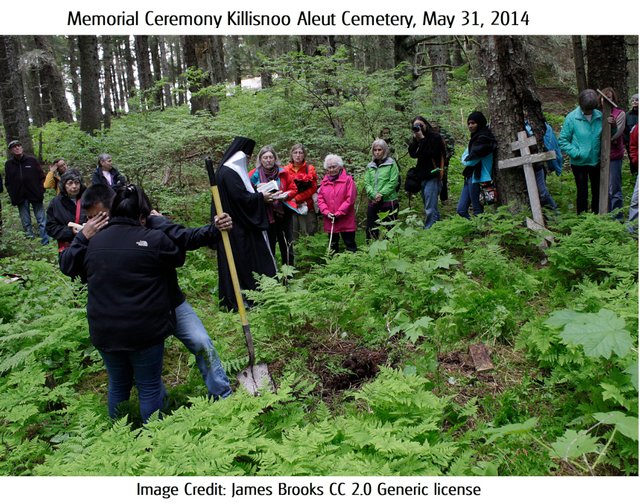
Thank you for this excursion through history about a folk I never have heard before, either. I was reading with interest through the passages of your post and congratulate you for another good peace.
I've heard before that the Bering Road once formed a country passage. This connection between two continents is exemplary for the corresponding conflicts between people, who, as always, without intending it, also influence flora and fauna. On the other hand, the mixing of peoples, which took place before due to migration, shows that identification with a culture seems only very pronounced when one is in crisis situations. As far as peace is concerned, it seems to be a natural curiosity and fascination that brings people together. Bridges are therefore always both: danger as well as opportunity.
As it looks, and as Yuval Harari describes it in one of his books, the occupation of the country by armed conflicts is increasingly history and the conquest of territories on the basis of mineral resources is not very worthwhile, at least not through soldiers and bombardments (losing millions of people like in the great wars I and II). Let us hope that such detentions and expropriations of marginalized populations no longer take place, although there are always conflicts when large construction projects lead through nature conservation or residential areas of inhabitants. The hunger of the great civilizations for resources is unbroken, and it is luck rather than understanding when and where a human being is born.
If we look back, all of us have one or the other migration history in our family tree. Some need only go back very briefly, others need to wander along the centuries.
While reading I wondered if the times when small populations died out due to infectious diseases are over once and for all. The sensitive ecological balance and all living beings on this globe are inevitably interwoven, once again your blog post shows this fact. However, I wish you had mentioned besides the negative consequences of these conquest and loss facts as well as those shown on the other side. But probably it is difficult to find a balance in the historical records and evidence that every movement is as bad as it is good. Nevertheless one can respect and also be sad about the cruelty and deaths related.
For example, many Germans fear for their culture. And indeed, the question seems to be whether there is even such a thing as a unified German culture. I doubt it, because big mega metropolises and the extinction of handicrafts in connection with the resulting traditions undermine such things. We may therefore have the loss of many traditions and rituals, but this is a worldwide phenomenon, wherever large cities act as points of attraction and occupy the land around them. But the loss of identity has much less to do with the people themselves and, in my view, is much more due to architecture, roads, urbanism and technification than to religion and other cultural characteristics.
So, in my heart I feel that I myself am an invader as much as an invaded.
Hello Erika, Thank you for that careful read and thoughtful comment.
What is the good side? I can't think of it. Progress? What is that except one culture gaining dominance over another, one idea of value winning over another. These people were virtually annihilated. I can't find the good in that. The environment was pillaged and altered for the worse. Species disappeared. Landscape degraded. Where is the good? Only that the indigenous people were somehow able to reclaim what had been taken from them. But they can't reclaim lives lost, can they? No, I don't see good here.
The issue of contact is one that has interested me for some time. There's a site (there are actually many sites) that discusses the pros and cons of contact:
https://bigthink.com/scotty-hendricks/there-are-more-than-100-uncontacted-tribes-in-the-world-who-are-they
It's a complicated issue. But what is not complicated in life :)
Yes, we are all hybrids. We all come from somewhere and have in a sense been invaders. When you think about it, human progress is predicated on the exploitation of resources...land, animals, air. Now that 'progress' has brought us to where we are, many people are considering how we might have progress without doing so much harm. How we might return as much to nature and others as we take. I know you live like that. Thinking here of your compost on the balcony :) And your bicycle..and other aspects of your thoughtful approach to life.
Without progress we wouldn't have vaccines, or electricity. I love those. But perhaps we can go forward without predatory progress.
Yes, we are invader and invaded, all at the same time. Nothing in life is simple, is it?
Have a great weekend, Erika.
Warm regards,
AG
Of course not, me neither .... My way of thinking is rather to look for examples that emphasize the good in times of need and expulsion. You know, I have my own family history that is shaped by it. Since things cannot be undone and have already happened, and I am probably particularly receptive to such reflections, I feel the need to read encouraging and positive additions to your and similar publications. Every story, no matter how devastating it may be, at some point allows for another story that may have happened precisely because the events were dramatic. I am interested in further narratives, such as that of the nurse who witnessed the lack of help from the doctor. What happened to her, how did her further life go? Are there any records, is there anything to tell that gives back courage and hope? Had she not witnessed such inhuman events, would she perhaps have led a life of indifference? And so on.
I am probably tired of reading the many cruel examples of human history and stressing the horrors that resulted. I'm sorry if I left that out too much on your article. I tend to.
Right, contact always takes place at the border. These boundaries between all living things always have their versatile effects, some dramatic, others useful, and yet others necessary. Life cannot be stopped nor controlled and when and by what one dominates the other, always a story with many facets, influencing factors and surprises.
The friction between two people takes place at their respective borders, too, which we once made a topic of in my training and thereby witnessed and exchanged our physical-psychical experiences. For this purpose we placed ourselves directly in front of each other and looked intensively and wordlessly into the eyes of the other. This was a rather unpleasant as well as surprising experience, because one rarely does such a thing.
On the peoples still untouched by civilization: there is an episode of spaceship Voyager, which I find quite apt. The only way to avoid this contact forever would be an impenetrable barrier of a physical nature. Such an energy field is mere fantasy, of course, and I'm glad there's no such thing.
History likes to summarize whole peoples and tell a collective event. But if you are a contemporary witness and involved, you know that these are individual events and that nothing in the world runs for twenty-four hours on seven days neither cruelly nor beautifully.
Yes, that is not the question? How we keep what we have achieved in good or development without killing or destroying. It is a question that every individual is challenged to answer, and it is by no means a question that one never tires of asking.
How I see it, the human species won't be able to be totally without predatory aspects. ... I remember my mom who said: "My father was a wise man. He knew how to avoid conflicts and when he should talk and better be quiet." But this quietness of my grandfather didn't make him bitter. He was a cheerful old man. Made the best out of life as it seemed to me.
Yes, I see your point. I think that would make an excellent blog. I read many witness statements that described kindness. From the nurse, to some of the Japanese who guarded prisoners in Japan. There were good stories. These of course were the exception, but they matter and are part of the picture. There were people in towns that neighbored the internment camps. Some of these people helped the internees.
I look at my own family's history, settling in the Americas hundreds of years ago. People lived here then, and my ancestors drove them out. That's a fact. So we all have blood on our hands, metaphorically speaking.
I agree that we can't go around with a sense of hurt and allow that to color everything we see. But, unfortunately, the history of the world is told by the conquerors. And that story has rarely in the past allowed truth to come out. So I guess I'm doing my part to balance the record.
I appreciate your reminder that much good exists among the bad. We should not lose sight of the good.
I end here with positive thoughts...about my friends on Steemit and the good influence they hope to have here.
Thanks again, Erika, for reading, for your insight, and for your comments.
With regard,
Your friend, AG
Hey, friend.... I love your flower !!!!!
Be happy, be peaceful.
Love, AG
I can't read the whole post at one time! So many infos... Perhaps you need someone beside you who stops you some time for writing the same text but many posts ;-)))) LGG
😂
And I left so much out....😁
Hehe, that is art: to reduce to the important things... but you wrote an informational post, so there is often much to write... ;-)))) LGG
I had never noticed that this aleutian island trail is the result of the underlying tectonic plates. Thanks to the image in this post I put them together :)
PS disappointed they don't have a special species of owls :(
Ok, so maybe not a special species of owl, but how about the only sighting of one species, ever, in North America. The Northern Boobook on St. Paul Island, Pribilofs
And I didn't know about the plates either. Actually, I didn't know any of this information. I've been reading for 3 weeks :)
It looks like it is silently judging me D: @regularowl come to say hi
(I can't believe I just upvoted my own comment...the owl is judging me, not you!)
I think it may be doing just that! 😁
The owls were called by @mathowl
I don't know where you find these, but they make my day :)
Hey @agmoore2, thanks for discussing the issue of the Aleutian Islands. I often wonder when people say: "Besides Pearl Habour, no bomb was dropped on the US in WWII." Usually, I reply: "But what's about the Aleutian Islands?". And I'm always surprised that no one has them on their radar.
Anyway, very nice and rich article. This article covers many many various aspects from history over geography, ecology, etc. Therefore, it definitely deserves a STEm upvote.
I calculated some facts about the Aleutian Islands: The Aleutian Islands cover an area which is about 5% of Germany. But having only 0.1% of the population in comparison! It is a very wild place and this probably protects the natives from being expelled. Nevertheless, with all the vulcanos and cold (even though I was surprised that it's not that cold as I expected) perhaps most people don't want to live there. How can I imagine a city on the Aleutian Islands? They are probably different from an "ordinary" US city, right?
Concerning the migration: Did I got it right that the people settled there between 5000 to 15000 years ago? But the Indians or ancestors of South America came earlier, or am I wrong? Were they just not in the mood to stay? Or conquered they America from another direction?
The problem with the rats and foxes are really sad. I don't know whether I already mentioned it, but I lived in Tasmania years ago and they had comparable problems. But it's nice to hear that they were able to remove at least some of the rats.
Once more thanks to you very much for the article, I will upvote and resteem.
Have a nice weekend
Best
Chapper
Thank you so much, for reading and supporting. I feared the blog was too long, but felt I needed all of it to give a complete idea of the place, the people, and their history. So glad there are patient people like you who work their way through it.
The answer to this is worthy of many blogs. As I read, I learned that there is by no means unanimity in theories about how and when the earliest "Americans" arrived. Or even the Aleutians. There is one theory that the migration to Alaska and the Aleutians was by sea, coming from the West. This theory is not much in favor. Then recent discoveries in South America throw established dates and theories into doubt.
And then there's Thor Heyerdahl, who sought to prove the earliest Americans sailed from Mesopotamia.
The questions continue....
Most of the Aleutians are part of the Alaskan Wildlife Preserve. So I don't think large scale settlement would be possible, even if people were inclined. Today, only the indigenous people are allowed to slaughter seals, because the animals are protected.
As for Tasmania....
You cannot guess how interesting this is to me. I have earlier read (and have written) a small bit about Tasmania, as part of my exploration into effects of colonialism.
I even tweeted about Truganini
That must have been a fascinating experience. If I had a private jet (😅) I would visit that part of the world. The trip would be impossible for me now...I would never survive 😁
Thanks, again for reading and for the interesting comments. It seems every time a question is answered another tantalizing one arises.
Have the most wonderful, peaceful weekend.
Warm regards,
AG
Hey @agmoore,
I also heard about things like this. In combination with aspects, we already discussed these theories could be proven.
Yeah, that's good. Not only for the seals ;-)
That's the curse of a good article. The better you attract peoples attention and understanding, the more comments and further thoughts a being added.
Try one of the big A380 planes! They are really comfortable!
A perfect remaining weekend also to you
Cheers
Chapper
A 380 ! Why didn't I think of that! Tasmania, here I come!
(That's your personal GIF 😄)
Thank you for your kind words--it makes a difference. Don't work too hard this week :)
Warm regards,
AG
So far it's ok!
Thanks
Chapper
This post has been voted on by the SteemSTEM curation team and voting trail. It is elligible for support from @curie and @utopian-io.
If you appreciate the work we are doing, then consider supporting our witness stem.witness. Additional witness support to the curie witness and utopian-io witness would be appreciated as well.
For additional information please join us on the SteemSTEM discord and to get to know the rest of the community!
Thanks for having added @steemstem as a beneficiary to your post. This granted you a stronger support from SteemSTEM.
Thanks for having used the steemstem.io app. You got a stronger support!
Thank you, SteemSTEM. What a nice thing to wake up to. I'm grateful.
Hi @agmoore2!
Your post was upvoted by Utopian.io in cooperation with @steemstem - supporting knowledge, innovation and technological advancement on the Steem Blockchain.
Contribute to Open Source with utopian.io
Learn how to contribute on our website and join the new open source economy.
Want to chat? Join the Utopian Community on Discord https://discord.gg/h52nFrV
Thank you very much, @utopian-io!
I somehow overlooked this post ... great, well-documented article ... about things that I mostly didn't know ... it was very interesting ... super.
Thank you! History is really my strong suit. I can get lost in an obscure subject and bore people to tears. So I'm glad I was able to make this subject interesting to others. Thank you for reading. I'll have to visit your blog now. Hope to see your entry in @shaka's contest. You are one of the best :)
Hehe more obscure more surprising and interesting to me ...that applies also to the movies, music, almost everything ... hope you will come soon with some more obscure details from history
Hello!
This post has been manually curated, resteemed
and gifted with some virtually delicious cake
from the @helpiecake curation team!
Much love to you from all of us at @helpie!
Keep up the great work!
Manually curated by @steemflow.
I didn't know helpie was a witness. Off to vote now :) It's like the tooth fairy leaving a surprise under the pillow. Really feels good to be acknowledged. Thanks.
Congratulations @agmoore2! You have completed the following achievement on the Steem blockchain and have been rewarded with new badge(s) :
You can view your badges on your Steem Board and compare to others on the Steem Ranking
If you no longer want to receive notifications, reply to this comment with the word
STOPVote for @Steemitboard as a witness to get one more award and increased upvotes!